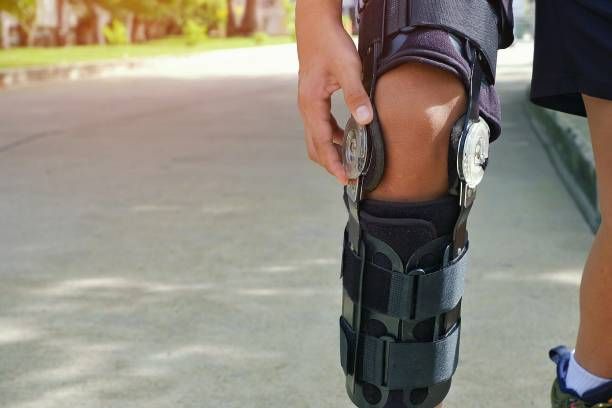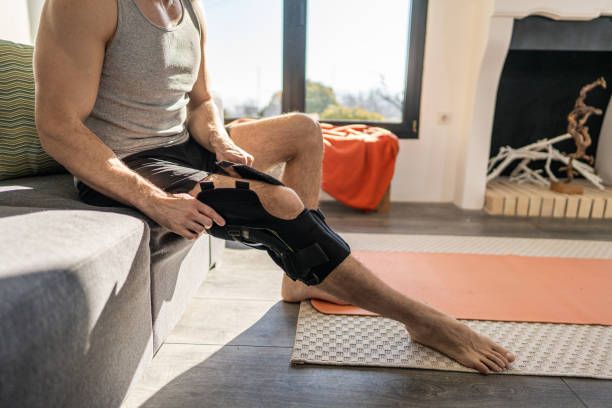john@lee-mat.com
+86-13510662576

GET QUOTE
A Step-by-Step Guide to Clean Your Knee Brace
Ensuring the cleanliness of your knee brace is essential not only for maintaining personal hygiene but also for prolonging its lifespan and effectiveness. In this comprehensive guide, we'll delve into the step-by-step process of cleaning your knee brace effectively to keep it hygienic and functional for longer.
Why Cleaning Your Knee Brace is Crucial?
Regularly cleaning your knee brace is imperative due to the significant implications it holds for both hygiene and the brace's performance. Neglecting to clean your brace can lead to unpleasant odors, skin irritation, and even infections due to the accumulation of sweat, dirt, and bacteria. Moreover, a clean knee brace functions more effectively, providing better support and comfort to your injured or vulnerable knee. It's also crucial to consider material-specific concerns, as different knee brace materials may require different cleaning approaches to maintain their integrity and functionality.
Can You Safely Wash a Knee Brace?
Addressing Common Concerns
Many people wonder if washing their knee brace will cause it to shrink or become damaged. While some knee braces, especially those made from materials like neoprene, may be susceptible to shrinking under certain conditions, proper washing techniques can help mitigate this risk. Additionally, concerns about damaging integral components such as Velcro straps or hinges are common. However, most high-quality knee braces are designed with durability in mind, and following manufacturer's guidelines for washing can help preserve these vital elements.
Factors to Consider when washing an orthopedic knee brace
When washing your knee brace, there are several factors to consider to ensure a safe and effective cleaning process. These include the material your brace is made of, as different materials may require different cleaning methods. It's also important to follow any specific instructions provided by the manufacturer regarding washing and drying your knee brace. By considering these factors and taking proper precautions, you can safely wash your knee brace without causing damage or compromising its functionality.
How to Wash a Knee Brace: Proper Cleaning Techniques
Preliminary Steps
Before washing your knee brace, it's important to take some preliminary steps to ensure a thorough cleaning process. This includes removing any detachable parts, such as hinges or metal inserts, and checking the manufacturer's guidelines to determine if these components can be separated for cleaning. Additionally, verifying the material your brace is made of will help you choose appropriate cleaning agents and methods.
Choosing Suitable Cleaning Agents
When selecting a cleaning agent for your knee brace, it's best to opt for a mild detergent or soap. Harsh chemicals, bleach, or fabric softeners should be avoided as they can damage the brace's materials and irritate your skin. A mild detergent will effectively remove sweat, dirt, and bacteria without compromising the brace's integrity. For braces with strong odors, a mixture of water and vinegar can help neutralize smells without damaging the brace.
Step-by-Step Hand-Washing Process
Hand-washing is often the preferred method for cleaning knee braces as it allows for more gentle and controlled cleaning. To hand-wash your knee brace, fill a basin or sink with lukewarm water and add the mild detergent. Immerse the brace and gently agitate it to dislodge dirt and sweat, paying special attention to areas with Velcro straps and hinges. After cleaning, rinse the brace thoroughly with water to remove any residual detergent.
Tips for Machine Washing
If you choose to machine wash your knee brace, use a gentle cycle with cold or lukewarm water. Placing the brace in a mesh laundry bag can help protect it from tangling or snagging during the wash cycle. Avoid using bleach or strong detergents, as they can damage the brace's materials. Additionally, always follow any specific instructions provided by the manufacturer regarding machine washing your knee brace.
Drying Methods to Preserve Your Brace
After cleaning your knee brace, how you dry it is just as important as the cleaning process itself. Gentle drying methods help preserve the integrity of the brace's materials and prevent damage. Proper drying ensures that the brace maintains its shape and effectiveness for longer periods.
Air Drying vs. Low Heat Drying
Air drying is often the safest method for drying your knee brace. Lay the brace flat on a clean towel and gently pat it to remove excess water. Avoid wringing or twisting the brace, as this can distort its shape and compromise its functionality. If you must use a dryer, opt for a low heat setting to prevent shrinkage or damage. However, air drying is generally preferred as it's gentler on the brace's materials.
Tips to Prevent Shrinkage and Damage
To prevent shrinkage and damage while drying your knee brace, it's essential to follow a few key tips. Firstly, never use a high-heat dryer, as this can cause the brace to shrink or damage its components. Instead, allow the brace to air dry naturally in a well-ventilated area. If you need to speed up the drying process, use a fan or set the dryer to a low heat setting. By following these tips, you can ensure that your knee brace remains in optimal condition after washing.
Additional Care and Maintenance Tips
Preventive Maintenance Strategies
In addition to regular cleaning, preventive maintenance strategies can help extend the lifespan of your knee brace. Take the time to inspect your brace regularly for any signs of wear or damage. Addressing minor issues early can prevent them from escalating into more significant problems and prolong the brace's effectiveness. Additionally, rotating between multiple braces, if possible, allows each brace to air out and dry thoroughly between uses, reducing the risk of odor and bacterial growth.
Proper Storage Practices
Proper storage is essential for maintaining the integrity of your knee brace when it's not in use. Always ensure that the brace is completely dry before storing it, as moisture can lead to mildew and bacteria growth. Choose a clean, dry area to store your brace and avoid storing it in places where it can come into contact with sharp objects or be bent or torn.
Addressing Common Issues
Despite your best efforts, your knee brace may encounter some common issues over time, such as stains, tears, or loose fittings. For stains, follow the cleaning steps mentioned earlier and consider using a stain remover that is safe for the brace's material. Small tears or loose seams can often be repaired with fabric glue or needle and thread. Regular maintenance and prompt attention to any issues can help keep your knee brace in top condition for longer.
Read more: 10 Tips for Keeping Your Knees Healthy
Knowing When to Replace Your Knee Brace
Signs of Wear and Tear
It's important to know when it's time to replace your knee brace to ensure continued effectiveness and support. Signs of wear and tear such as fraying, tears, or detached components indicate that the brace may no longer provide the necessary support. Additionally, if you notice a decline in the brace's ability to support your knee or maintain compression, it may be time for a replacement. Regularly inspecting your brace for these signs can help you determine when it's time for a new one.
Importance of Monitoring Functionality
Monitoring the functionality of your knee brace over time is crucial for ensuring optimal performance. As you use your brace, pay attention to any changes in its fit, support, or comfort level. If you notice any significant changes or deterioration in performance, it may be a sign that the brace needs to be replaced. By staying vigilant and proactive in monitoring your brace's functionality, you can ensure that you always have the support you need.
Conclusion
Proper cleaning and maintenance are essential for ensuring the hygiene and durability of your knee brace. Regular cleaning helps prevent odors, skin irritation, and bacterial growth, while proper maintenance extends the lifespan of the brace. By following the steps outlined in this guide, you can keep your knee brace in top condition for longer.
We invite you to explore our selection of high-quality orthopedic knee braces at Lee-Mat. Whether you're in need of a replacement or looking for a new brace, we offer a wide range of options to suit your needs. With our durable and effective knee braces, you can continue to enjoy the support and relief you need for your knee-related issues.
More FAQs About Cleaning a Knee Brace:
Q: Why is it important to clean knee braces besides keeping odor away?
A: Maintaining and cleaning your knee brace will help extend its life, especially since medical or athletic braces can be costly. Regular cleaning also prevents health problems such as folliculitis, ringworm, and staph infections.
Q: How often should you clean your knee brace?
A: The frequency depends on the type of brace and your activity level. Simple sleeves or braces without metal components can be laundered every few days. Larger braces with metal structures should be wiped down daily with a damp cloth or baby wipe to prolong their life and ensure comfort.
Q: How to Clean a Hinged Knee Brace?
A: To clean a hinged knee brace, remove any detachable parts and hand wash the brace in warm water with mild soap. Rinse thoroughly and air dry completely before reassembling.
Q: How to Clean a Knee Brace with Metal?
A: For a knee brace with metal components, detach the metal parts if possible. Wash the fabric parts with mild soap and water, avoiding soaking the metal. Wipe the metal parts with a damp cloth and dry them immediately to prevent rust.
Q: How to Clean a Neoprene Knee Brace?
A: Clean a neoprene knee brace by hand washing it in cold water with a mild detergent. Rinse well to remove all soap and lay flat to air dry, avoiding direct sunlight to prevent material degradation.
Q. How to Clean an ACL Brace?
A: Clean an ACL brace by hand washing it with mild soap and warm water. Rinse thoroughly and allow it to air dry. Avoid machine washing or drying to maintain the brace's integrity and effectiveness.
Q: What other maintenance do knee braces need?
A: Maintenance varies by brace type. Hinged braces may need lubrication, and straps should be inspected regularly for wear and tear. Some manufacturers offer replacement parts for worn components.
Q: Can a dirty knee brace cause skin problems?
A: Yes, a dirty knee brace can cause skin irritation, including redness, chafing, and even painful blisters. Regular cleaning prevents these issues and ensures the brace remains comfortable to wear.
Q: How should you store your knee brace to maintain cleanliness?
A: Store your knee brace in a well-ventilated area, avoiding gym bags or other enclosed spaces that do not get good airflow. Ensure the brace is clean and dry before storing it to prevent bacteria and odor buildup.


